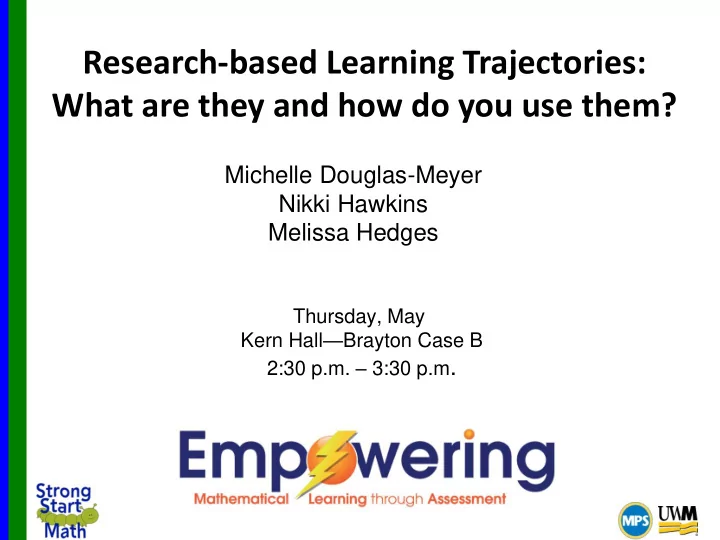

Research-based Learning Trajectories: What are they and how do you use them? Michelle Douglas-Meyer Nikki Hawkins Melissa Hedges Thursday, May Kern Hall — Brayton Case B 2:30 p.m. – 3:30 p.m .
Agenda • Introduce learning trajectories • Examine the comparing trajectory • Consider instructional moves to encourage student movement along the comparing trajectory
Learning Targets We will • Gain knowledge around learning trajectories, specifically the comparing trajectory. • Deepen our understanding of the developmental progression children follow as they learn to compare quantities. • Understand how to support student’s movement on a learning trajectory, using the comparing trajectory.
Success Criteria We will be successful when we can make use of the comparing trajectory for instructional planning.
Learning Trajectories
Learning Trajectories: An Introduction https://www.youtube.com/watch?v=0KiBDbNvQF0 Share with your partner your understanding of the three parts of a math learning trajectory.
Three Parts of a Math Learning Trajectory 1. Math Goal • Include big ideas (Foundational Concepts) 2. Developmental Path • Typical developmental learning route 3. Instructional Tasks • Matched to each level of thinking • Promote children’s growth from one level to the next
Why Use Learning Trajectories? Doug Clements https://www.youtube.com/watch?v=OSL6x4iBpCk According to Doug Clements, how might an understanding of learning trajectories benefit both students and teachers?
Three Research Findings 1. Learning substantial math is critical for primary grade children. 2. All children have the potential to learn challenging and interesting math. 3. Understanding children’s mathematical development helps teachers be knowledgeable and effective in teaching math.
The Learning Trajectories Approach Read and highlight: p . 2 “Teaching Challenging and Interesting Math” Share two ideas you highlighted and why you found them important.
Exploring the Comparing Trajectory Read through each level of the developmental path children travel on as they learn to compare quantities. Place them in the order that makes sense to you as you reflect on how children develop and grow in their understanding of comparing quantities.
Comparing Quantities Progression • Compares same-sized collections of physically similar objects of 1 – 6 by matching. Identifies collections as “the same.” • Compares different-sized collections of 1-6 of physically similar objects by matching. Identifies collections as “more,” “less” or “the same.” • Compares collections of same-sized objects in groups of 1-5 by counting. Identifies collections as “more,” “less” or “the same.” • Compares accurately by counting, even when larger collection’s objects are physically smaller up to 5. Able to figure out how many more or less. • Compares sets by counting, even when larger collection’s objects are physically smaller, up to 10. Able to figure out how many more or less.
Asher and the Bear and Chairs Where would you place Asher on the comparing trajectory? Why?
Checking in As you reflect on the trajectory, what are some of the characteristics of this learning trajectory that would be helpful during instructional planning?
A DEEPER UNDERSTANDING OF COMPARING
Supportive Language When children are learning the relationships of more and less, the language we commonly use can sometimes get in the way. In order to have children consider these relationships without the interference of difficult language structures, we have to change the language and the setting. We can help children compare groups of different sizes by using language patterns that they can understand more easily. Richardson, K. (1999). Developing number concepts: Counting, comparing, and pattern (Book 1). Dale Seymour Publications: Parsippany, NJ.
Begin with natural contexts What are some contexts that occur during a young child’s day when they need to compare quantities? Crackers and children Toy trucks and blocks to park on Dolls and bibs Coat hooks and jackets
What will happen? Will every _____ get a _____? Show me how you know. Are there extra What can we do _____ or _____? to make the How many _____ won’t get a _____? How many extra groups the _____ will there be? same? How do you know? Teacher models comparative statement: “So , there are more _____ than _____.” or “So, there are fewer _____ than _____.” How many more _____ than _____? How many fewer _____ than _____?
Ms. Douglas-Meyer asked 6 children to grab a pillow and join her in the math corner.
What will happen? Will every child get a pillow? Show me how you know. Are there extra What can we How many pillows or children? do to make children won’t get How many extra the children a pillow? children will there and pillows be? the same? How do you know? Teacher models comparative statement: “So , there are more children than pillows.” or “So, there are fewer pillows than children.” How many more children than pillows? How many fewer pillows than children?
Practicing with some natural contexts. There are six bears and 4 chairs. There are 11 milk cartons and seven straws. There are five friends at the birthday party. There are eight balloons.
What will happen? Will every milk get a straw? Show me how you know. Are there extra What can we How many straws or cartons? do to make cartons won’t get How many extra the cartons a straw? cartons will there and straws be? the same? How do you know? Teacher models comparative statement: “So , there are more cartons than straws.” or “So, there are fewer straws than cartons.” How many more cartons than straws? How many fewer straws than cartons?
Learning Targets We will • Gain knowledge around learning trajectories, specifically the comparing trajectory. • Deepen our understanding of the developmental progression children follow as they learn to compare quantities. • Understand how to support student’s movement on a learning trajectory, using the comparing trajectory.
http://uwm.edu/education/research/centers/cmser/strong-start-math/ Thank you for coming!
Recommend
More recommend